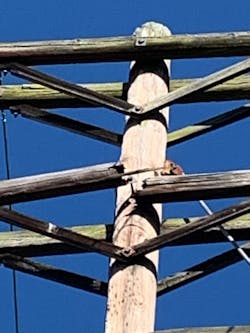PSE&G’s field workforce identifies circuits with the most outages and service interruptions during the utility’s annual inspection. The engineering technicians then analyze the Poorest Performing Circuits by locating and logging defects and assessing the circuits’ overall condition.
While this process has been repetitive in nature and managed heavily by outage data, the technicians were still performing the field work on paper. As a result, it required more time to get the field work located, prioritized and planned.
To bridge the technology gap without altering the current workflow, PSE&G’s product team developed a lightweight and cost-effective solution. Mobile Electric GIS Application (MEGA), which was built in-house and leverages Esri core tools to help the engineering department achieve faster and more accurate patrol results via the digital platform.
Implementing a Pilot Project
During the initial development of MEGA, the team discovered benefits in isolating, replicating and enriching data from the GIS environment. Through a data ingestion method, a copied dataset is automatically published to the organizational ArcGIS Online cloud location. Once the data is shared online, the Esri core tools, including Collector for ArcGIS and Survey123, consume this information from mobile devices so workers in the field can view the utility’s assets and potentially report their findings via surveys in Survey123.
PSE&G piloted MEGA with early stakeholders for potential use cases. For example, Ed Gray, director of transmission and distribution engineering, electric and gas asset strategy, leveraged this mobile platform for data logging and analytic capabilities to enhance the Asset Reliability program he oversees.
“This technology enables not only process efficiency in identifying and prioritizing repairs of defects on our system, but also opens a new level of reliability analytics to help us make informed decisions on programs and investments,” he says. “In addition to reliability, we’ll be using the tool to identify and prioritize repairs on public safety issues as well.”
With Esri core tools, the MEGA team is able to quickly adopt application enhancements/modifications based on client requests. This aligned well with the PSE&G IT organization’s policy to practice the Agile methodology for products/projects under development. Whenever a change request comes in from a client, it is typically released in the following sprint.
Esri’s scalable and administered core tools, combined with the MEGA team’s adherence to the Agile methodology, provided “self-marketing” of the platform. With key stakeholders advocating the success, and actual users preferring the lightweight mobile app over other systems, obstructed with firewalls and specialized GUIs requiring niche navigational expertise, the app took off in popularity.
Refining the App
Today, any end-user with MEGA access has the ability to view GIS model data and compare it to what is seen in the field within seconds. In addition, the team developed an additional means to report GIS corrections in MEGA. By using Collector and building a smart hyperlink to auto-populate the data from the map into a form in Survey123, anyone is able to report data issues by placing a geo-located point on the issue found in the field.
The technology produces crowdsourced data QA/QC for the Reliability and GIS departments. The crowdsourced defects/faults on PSE&G’s equipment, blended with MEGA’s auto populating asset information and an image attached to the record, gives an all-in-one use case for field workers and technicians.
The utility has discussed further enhancements to the MEGA platform and data collection process by having design sessions with electric division supervisors and managers. These sessions finalized digital processes and workflows allowing prioritized categories of defect types and a public safety hazard flag on each record. The data collection effort at this point was in “production” status, yet the MEGA team is always ready for new user stories and development for enhancements.
Customizing an Office Platform
Back in the office, the supervisors and executives responsible for decision making on the indicated work collected from field surveys needed a platform just as capable and user friendly. The MEGA team used the same data that was feeding Collector, for in-office web apps as well. The various functions performed in the office are also streamlined by providing pre-built data dashboards and visual summaries with simple select style query builders for quick insight.
Another office-based tool is the algorithm provided by Gray’s team to “score” each circuit based on the type of defect found and a “likeliness” weighted value in which it could cause an outage to customers. This analytic function is built within the dashboard code, giving all the high-value answers to important questions as soon as the page loads.
With all the data streaming into the office, PSE&G had a need to ensure work scheduling/management functions were happening just as fast. The PSE&G Robotic Process Automation team in IT helped to develop a bot to build work orders based on certain high priority damage items found in the field. This bot enters all required information into the work management system and updates the record in ArcGIS Online, accordingly. It also completes periodic status checks to close each record once the scheduled work is indicated complete in the work management systems. This process would otherwise be very labor intensive, requiring sketches and estimates be created for each item. MEGA provides an estimated performance increase of 500% on each record.
The Agile methodology was a key factor in the group’s success. Ongoing support, training, enhancements and development in these processes allows for near seamless adoption of similar efforts in the field, leading the MEGA team to begin working on Storm Damage Assessment and an Electric Transmission inspection tool/platform. MEGA is becoming a well-known solution within the utility company. The team has accomplished the progress so far in a year-and-a-half with only a handful of people on the team. The team is anxious to keep this pace and help develop solutions to other roadblocks in work as they arise.
Bryan Serino is a technology group product owner in the Utility Technologies Smart Operations department for PSE&G
in New Jersey. His seven-year career started in gas distribution data Analytics and he has now supported multiple mobile application projects across the electric & gas utility including GIS and OMS mobile applications system integration.
Steve Zinser is a technology group product manager in the Utility Technologies Smart Operations department for PSE&G in New Jersey. His 30-year career started in distribution engineering and has spanned various roles across the electric utility. For the past 22 years, he has implemented and supported technology projects including GIS, OMS and SCADA.





